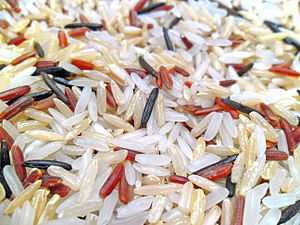Pusa 1121 Rice
Pusa 1121 is an essentially derived variety evolved through the process of hybridization over a long breeding process. The variety of basmati rice was developed by Indian scientists. This variety of rice is known for its extraordinary kernel (grain) length, which can be as much as 8.2 millimetres (0.32 in) for a single grain, the longest-ever known released cultivar in the world. It has very high kernel elongation ratio ranging from 2 to 2.5, i.e length of cooked rice kernel/length of uncooked kernel. When cooking this rice does not turn sticky, possesses minimum breadth-wise expansion, and is aromatic with intermediate alkali-spreading value and amylose content. All these attributes make it a delicious rice.
It was developed by the Indian Agricultural Research Institute (IARI) and released for commercial cultivation in kharif season of 2003. By 2007, the variety has become widely popular with farmers, as Pusa-1121 is photo-insensitive, requires less water, matures early and yields 19–20 quintals of paddy per acre as compared to 9–10 quintals for traditional tall basmati.[1]
As of 2013 Pusa Basamti 1121 had spread over 84% of the total basmati area in Punjab, 78% in Western Uttar Pradesh, 68% in Haryana, 30% in Uttrakhand, 8% in Jammu and Kashmisr and grown over a 1000-ha area in hill state of Himachal Pradesh. It is an important export commodity.[2] Its export has enhanced India's annual basmati foreign exchange earning from Rs 5000 crores in 2009 to Rs 11600 in 2013.
References
- ↑ "Pusa-1121 proved a major hit with farmers. publisher= Hindu Business Line". Dec 28, 2007. Retrieved 2013-09-13.
- ↑ Agri Net Solution Report Volume-4 (24 October, 2013)
